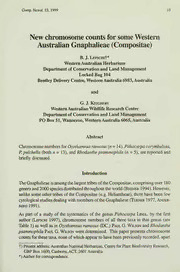
New chromosome counts for some western Australian Gnaphalieae (Compositae) PDF
Preview New chromosome counts for some western Australian Gnaphalieae (Compositae)
Comp. Newsl.33, 1999 19 New chromosome comits for some Western Australian Gnaphalieae (Compositae) B.J. LEPSCHit* WesternAustralianHerbarium DepartmentofConservationandLandManagement LockedBag 104 BentleyDeliveryCentre,WesternAustralia6983,Australia and G.J. Keighery WesternAustralianWildlifeResearchCentre DepartmentofConservationandLandManagement PCBox51,Wanneroo,WesternAustralia6065,Australia Abstract ChromosomenumbersforOzothamnusramosus(n= 14),Pithocarpacorymbulosa, P. pulchella (both n= 13), andRhodanthepsammophila (n = 5), arereported and brieflydiscussed. Introduction TheGnaphaUeaeisamongthelargesttribesoftheCompositae,comprisingover180 generaand2000speciesdistributedthroughouttheworld(Bremer 1994).However, unlikesomeothertribes oftheCompositae(e.g. Heliantheae), therehavebeen few cytologicalstudiesdealingwithmembersoftheGnaphaheae(Turner 1977,Ander- BERG 1991). As part ofa study of the systematics ofthe genus Pithocarpa Lindl. by the first author (Lepschi 1997), chromosome numbers of all diree taxa in that genus (see Table 1) as well as in Ozothamnusramosus (DC.) PaulG.Wilson and Rhodanthe psammophilaPaulG. Wilson weredetermined. This paperpresentschromosome countsforthesetaxa,noneofwhichappeartohavebeenpreviouslyrecorded, apart t)Presentaddress:AustralianNationalHerbarium,CentreforPlantBiodiversityResearch, GBPBox 1600,Canberra,ACT,2601Australia *)Authorforcorrespondence. 20 Comp.Newsl.33, 1999 from R. psammophila (see under Helipterum condensatum F. Muell., in Turner 1970).ItshouldbenotedthatO. ramosus doesnotbelongtoOzothamnussens,str., and will be transferred to a new genus along with a handful of other Australian speciescurrentlyplacedin Ozothamnus(C.F. Puttockpers.comm.). MaterialsandMethods Young,freshlycollectedbudswereplacedinasolutionof4partschloroform,3parts 95% alcohol and 1 part acetic acid. These were subsequently transferred to an acetocarmine stain, with meiotic material then examined after"squashing" pollen mothercells.Countsweremadeusingabinocularcompoundmicroscopewithanoil immersionachromaticlensgivingamagnificationofapproximatelyxlOOO,withup tofivecountsmadepercollection.Allbudmaterialwascollectedfi-omwildplantsin thefield,exceptforR.psammophila, forwhichmaterialwascollectedfromplantsin cultivation.VouchersforallcountsaredepositedatPERTH. ResultsandDiscussion Results obtained from this study are presented in Table 1. Taxa are arranged alphabetically. Table 1.ChromosomenumbersinsomeWesternAustralianGnaphaheae. Taxon Comp.Newsl.33, 1999 21 The paucity ofcytological studies on the Gnaphalieae unfortunately limits what inferences can be drawn from the data presented here. However, some general observationscanbemade. Solbrigetal. (1964) andSolbrig(1977)notethatinthe Compositae, perennial species generally have higher chromosome numbers (i.e. greaterthan n=9)whileannualspecies,particularlythosefromaridareas,tendto havelowerchromosomenumbers.OurdataagreeswiththatofSolbrigetal.(1964) and Solbrig (1977), with O. ramosus (n = 14) andPithocarpa spp. (n = 13) being perennial species from the relatively mesic south-west ofWestern AusU-alia, and with R. psammophila {n = 5) being an annual species restricted to the Carnarvon districtineremeanWesternAustraUa. Breedingsystemsandchromosomenumbersmayalsoshowsomecorrelation, with higherchromosome numbers (i.e. greater than n = 9), often found in outbreeding taxain the Compositae (Solbrig 1977). Studies by the first author (Lepschi 1997), suggestthatallPithocarpaspp.areoutbreeders,andthecorrespondingchromosome number ofn = 13 for all taxa in the genus is consistent with this. The breeding systemsoftheothertaxaincludedinthisstudy haveyettobedetermined. Directcomparisonofchromosomecountsobtainedfortaxainthisstudy withthose ofrelated species is unfortunately not possible for most taxa. The only published chromosome counts for species of Ozothamnus are those reported in Hair & Beuzenberg (1968) for seven New Zealand species (as Helichrysum spp.), all of which are n = 14. However, as mentioned above, O. ramosus does not belong in Ozothamnussens, str., andcomparison ofchromosome numbers in this taxon and theNewZealandspecieswouldnotbeparticularly meaningful atthis stage,except forrelationships atthegeneric level. Furthertaxonomicandcytological studies on Ozothamnusareurgentlyrequired. Thecountofn=5 obtainedforR.psammophilaconfirmsthatreportedbyTurner (1970;asHelipterumcondensatum).RhodantheLindl.,aspresentlycircumscribed, is a heterogeneous assemblage (Anderberg 1991, P. G. Wilson pers. comm.) the members of which exhibit great variation in chromosome numbers. As with Ozothamnus, further systematic and cytological studies are needed to clarify the significance ofthis variation. Therelationships ofPithocarpa arenotclear, butthe resultsofarecentphylogeneticstudy ofPithocarpa(Lepschi 1997), suggestthatits closest affinities may be with taxa ofthe 'Lawrencella complex' ofgenera (sensu Anderberg 1991).However,Lepschi(1997)studiedonlyaselectionofthepotential relativesofPithocarpa(includingArgentipalliumniveum (Steetz)PaulG.Welson and O. ramosus oftheL<zwrence//acomplex),andamore comprehensivesamphng oftaxa would be required to accurately determine the sister taxon to Pithocarpa. 22 Comp.Newsl.33, 1999 Data on chromosome numbers in genera ofthe Lawrencella complex is poor, but chromosome numbers ofn = 8, 11 and c. 24 have been reported (Turner 1970). Anderberg(1991)alsorecords«= 14,butthisappearstobeinerror.Argentipallium niveum, which appears as the sistertaxon to Pithocarpa in the analysis ofLepschi (1997)hasachromosomenumberof«=c.24(Turner1970;asHelipterumobtusifo- liumSoND.). Acknowledgements Theauthors aregratefultoDaveCoatesandVickiHamleyforlaboratoryfacilities, and BJLwishestothankTerenaLallyforassistancewithfieldwork. References Anderberg, A. A. 1991. Taxonomy and phylogeny of the tribe Gnaphalieae (Asteraceae). OperaBot. 104: 1-195. Bremer, K. 1994. Asteraceae: Cladisticsand Classification. TimberPress, Port- land,Oregon. Hair,J. B. & E.J. Beuzenberg 1968. Contributionstoachromosome atlas ofthe New Zealand flora 2. Miscellaneous families. New Zealand J. Bot. 6: 19-24. Lepschi,B.J. 1997. AtaxonomicrevisionofPithocarpa(Gnaphalieae:Asteraceae) and an assessment ofits phylogeny. Unpublished Postgraduate Diploma thesis, CurtinUniversityofTechnology,AustraUa. SoLBRiG,O.T. 1977.ChromosomecytologyandevolutioninthefamilyCompositae. In: Heywood,V. H., Harborne, B. J. &B. L.Turner(eds.), TheBiologyand Chemistryofthe Compositae, 1.AcademicPress,London, pp. 246-260. Solbrig, O. T.,Anderson, L. C, Kyhos, D. W., Raven, R H. & L. Rudenberg 1964. Chromosome numbers in Compositae V. Asterae U. Amer J. Bot. 51:513-519. Turner, B. L. 1970. Chromosome numbers in Compositae 12.Australian species. Amen J. Bot. 57: 382-389. Turner,B.L. 1977. Sununaryofthebiology oftheCompositae.In: Heywood,V. H.,Harborne, B. J. &B. L. Turner(eds.). TheBiologyandChemistryofthe Compositae, 2. AcademicPress,London,pp. 1105-1119.
